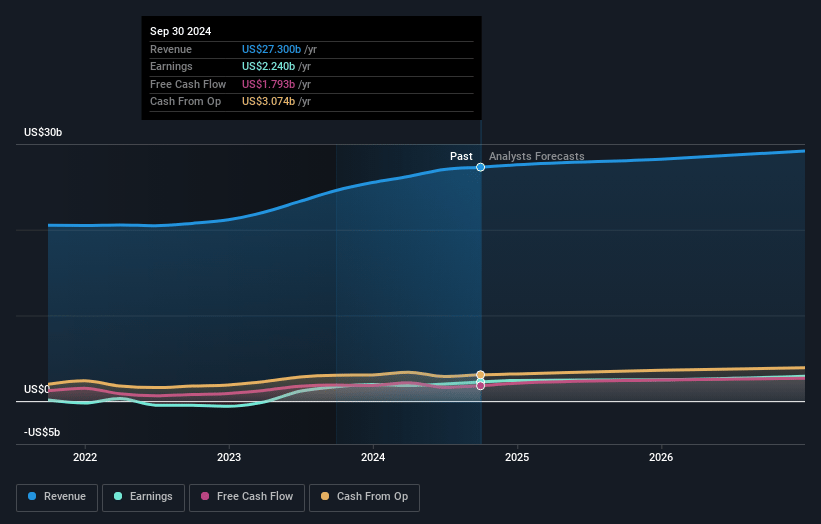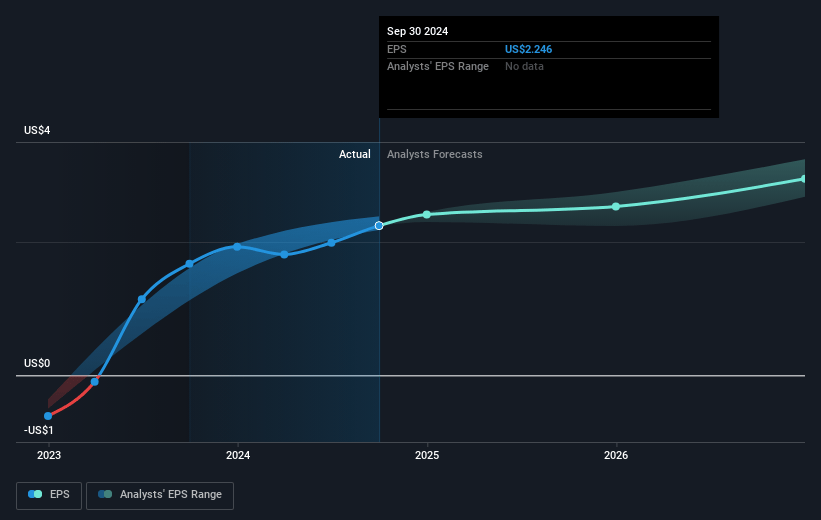Key Takeaways
- Significant gas infrastructure and LNG capacity demand are anticipated to drive revenue growth through equipment sales and service agreements.
- Improving operational efficiencies and focus on aftermarket services and decarbonization are expected to boost margins and enhance earnings.
- Geopolitical volatility, supply chain issues, and reliance on LNG projects pose risks, while cost-cutting may hinder future innovation, affecting Baker Hughes' growth.
Catalysts
About Baker Hughes- Provides a portfolio of technologies and services to energy and industrial value chain worldwide.
- Baker Hughes anticipates a significant increase in gas infrastructure orders, fueled by global demand for natural gas, which could drive revenue growth through more equipment sales and recurring service agreements.
- The company is strategically positioned in LNG outlook with expectations of 800 MTPA of liquefaction capacity needed by 2030, potentially boosting future revenue from equipment orders and service contracts.
- Margins are expected to improve due to initiatives like operational efficiencies, adopting process mindsets, and streamlining activities, directly impacting net margins and EBITDA.
- A focus on upgrades and technology investments for installed equipment will deliver higher revenue from aftermarket services, which generally have higher margins than initial equipment sales.
- Baker Hughes plans to leverage decarbonization technologies as a growth theme, expecting increased adoption which could enhance earnings as markets demand more sustainable energy solutions.
Baker Hughes Future Earnings and Revenue Growth
Assumptions
How have these above catalysts been quantified?- Analysts are assuming Baker Hughes's revenue will grow by 2.8% annually over the next 3 years.
- Analysts assume that profit margins will increase from 8.2% today to 10.8% in 3 years time.
- Analysts expect earnings to reach $3.2 billion (and earnings per share of $3.31) by about January 2028, up from $2.2 billion today.
- In order for the above numbers to justify the analysts price target, the company would need to trade at a PE ratio of 18.2x on those 2028 earnings, down from 19.1x today. This future PE is greater than the current PE for the US Energy Services industry at 14.6x.
- Analysts expect the number of shares outstanding to decline by 0.62% per year for the next 3 years.
- To value all of this in today's terms, we will use a discount rate of 8.05%, as per the Simply Wall St company report.
Baker Hughes Future Earnings Per Share Growth
Risks
What could happen that would invalidate this narrative?- Ongoing geopolitical uncertainties in the Middle East could create added volatility in oil prices, potentially impacting revenue and earnings from oil-related operations.
- Expected softer oil fundamentals in 2025 due to rising North American and deepwater production, along with planned OPEC+ increases, could lead to decreased demand for Baker Hughes' oilfield services and equipment, affecting revenue.
- While natural gas demand is projected to increase, dependency on large LNG projects and possible delays in project FIDs due to market or regulatory changes could pose risks to expected revenue growth.
- Supply chain challenges, like aeroderivative supply chain tightness in Gas Technology Equipment, could affect operational execution and the timing of revenue recognition.
- The emphasis on execution of cost-cutting measures and margin improvements may reduce R&D expenditures, potentially impacting future innovation and competitiveness, which could affect long-term revenue and earnings growth.
Valuation
How have all the factors above been brought together to estimate a fair value?- The analysts have a consensus price target of $47.64 for Baker Hughes based on their expectations of its future earnings growth, profit margins and other risk factors. However, there is a degree of disagreement amongst analysts, with the most bullish reporting a price target of $55.0, and the most bearish reporting a price target of just $34.0.
- In order for you to agree with the analyst's consensus, you'd need to believe that by 2028, revenues will be $29.6 billion, earnings will come to $3.2 billion, and it would be trading on a PE ratio of 18.2x, assuming you use a discount rate of 8.1%.
- Given the current share price of $43.28, the analyst's price target of $47.64 is 9.1% higher.
- We always encourage you to reach your own conclusions though. So sense check these analyst numbers against your own assumptions and expectations based on your understanding of the business and what you believe is probable.
How well do narratives help inform your perspective?
Disclaimer
Warren A.I. is a tool utilizing a Large Language Model (LLM) that ingests data on consensus price targets, forecasted revenue and earnings figures, as well as the transcripts of earnings calls to produce qualitative analysis. The narratives produced by Warren A.I. are general in nature and are based solely on analyst data and publicly-available material published by the respective companies. These scenarios are not indicative of the company's future performance and are exploratory in nature. Simply Wall St has no position in the company(s) mentioned. The price targets and estimates used are consensus data, and do not constitute a recommendation to buy or sell any stock, and they do not take account of your objectives, or your financial situation. Note that Warren A.I.'s analysis may not factor in the latest price-sensitive company announcements or qualitative material.
Read more narratives
There are no other narratives for this company.
View all narratives



